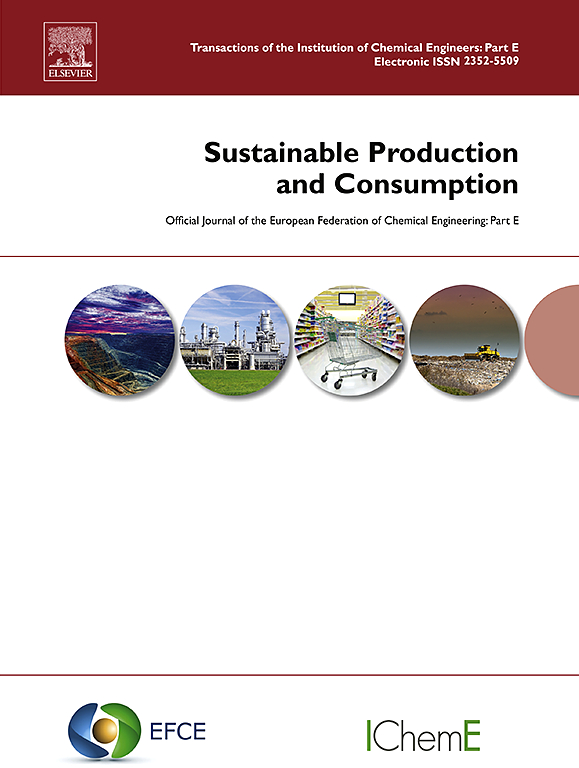为安全和可持续的设计实践提供决策支持框架,促进废物转化为能源供应链的循环
IF 10.9
1区 环境科学与生态学
Q1 ENVIRONMENTAL STUDIES
引用次数: 0
摘要
推进安全和可持续的废物转化为能源的供应链对于实现循环商业模式至关重要。然而,建立这样一个供应链需要解决其固有的复杂性,并制定缓解战略,以实施安全和可持续的设计实践。虽然早期的研究主要集中在可持续化学品和材料上,以促进可持续的设计实践,但可持续的废物转化为能源的供应链在很大程度上被忽视了。本研究系统地评估了考虑到相关不确定未来事件的挑战,并研究了安全可持续设计实践的实际实施的缓解策略。为了实现这一目标,开发了一种新的决策支持框架,该框架集成了基于梯形模糊的分层最佳-最差方法、质量功能部署和混合整数线性规划模型。数据从领域专家那里收集到框架的适用性。研究结果表明,“环境”维度构成了最关键的可持续性挑战,其中“WtE生命周期中污染预防的复杂性”被确定为最重要的子挑战。研究结果还表明,“优化废物转化为能源的生产,最大限度地减少排放”是最有效的缓解战略。此外,该模型表明,在预算和时间限制下,15项缓解战略中有9项可以同时实施,以有效缓解所审查的挑战。这些发现为决策者实时实施可持续设计实践提供了有价值的见解。此外,这些发现可能对食品加工、化学品、药品和服装等其他供应链在成功采用可持续设计实践方面具有全球性影响。本文章由计算机程序翻译,如有差异,请以英文原文为准。

A decision support framework for safe and sustainable by-design practices promoting circularity in waste-to-energy supply chains
Advancing a safe and sustainable waste-to-energy supply chain is predominant for achieving a circular business model. However, establishing such a supply chain requires addressing its inherent complexities and developing mitigation strategies for implementing safe and sustainable by-design practices. While earlier research has mainly focused on sustainable chemicals and materials for promoting sustainable by-design practices, the sustainable waste-to-energy supply chain has been largely overlooked. This study systematically evaluates challenges considering associated uncertain future events and examines mitigation strategies for the practical implementation of safe and sustainable by-design practices. To achieve this, a novel decision support framework is developed, integrating a trapezoidal fuzzy-based stratified best-worst method, quality function deployment, and a mixed-integer linear programming model. Data is collected from domain experts to the framework's applicability. The findings reveal that the ‘environmental’ dimension poses the most critical sustainability challenge, with the ‘complexity of pollution prevention in WtE life cycle’ identified as the most significant sub-challenge. The results also indicate ‘Optimize waste-to-energy production to minimize emissions’ as the most impactful mitigation strategy. Furthermore, the model demonstrates that within budgetary and time constraints, nine out of fifteen mitigation strategies can be simultaneously implemented to mitigate the examined challenges effectively. These findings offer valuable insights for policymakers for real-time implementation of sustainable by-design practices. Moreover, these findings may have global implications for other supply chains, such as food processing, chemicals, pharmaceuticals, and garments, in their efforts to successfully adopt sustainable by-design practices.
求助全文
通过发布文献求助,成功后即可免费获取论文全文。
去求助
来源期刊

Sustainable Production and Consumption
Environmental Science-Environmental Engineering
CiteScore
17.40
自引率
7.40%
发文量
389
审稿时长
13 days
期刊介绍:
Sustainable production and consumption refers to the production and utilization of goods and services in a way that benefits society, is economically viable, and has minimal environmental impact throughout its entire lifespan. Our journal is dedicated to publishing top-notch interdisciplinary research and practical studies in this emerging field. We take a distinctive approach by examining the interplay between technology, consumption patterns, and policy to identify sustainable solutions for both production and consumption systems.
 求助内容:
求助内容: 应助结果提醒方式:
应助结果提醒方式:


